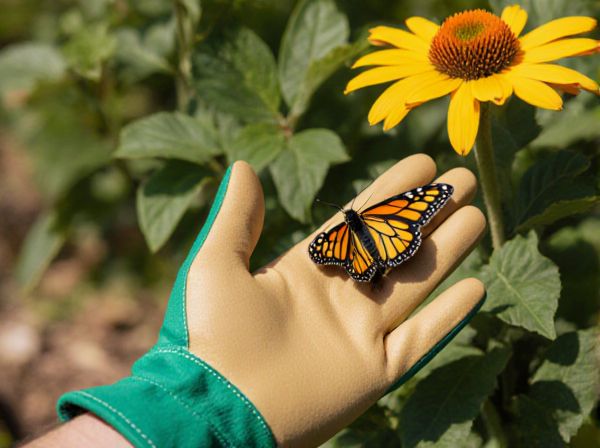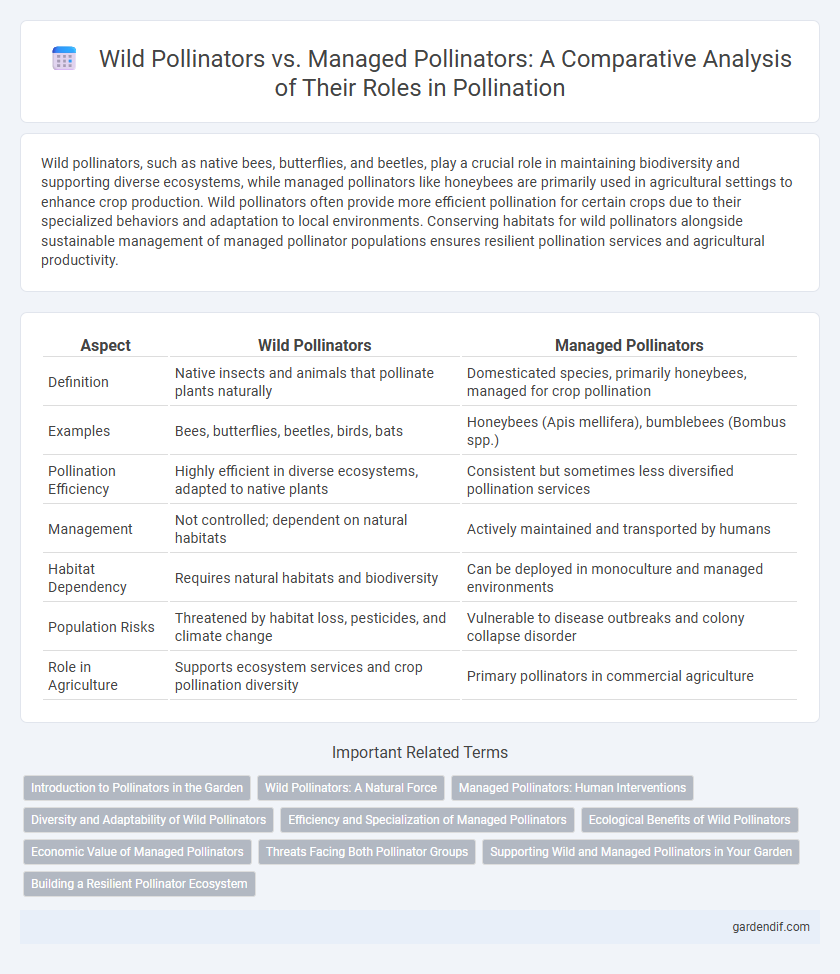
Wild pollinators vs Managed pollinators Illustration
Wild pollinators, such as native bees, butterflies, and beetles, play a crucial role in maintaining biodiversity and supporting diverse ecosystems, while managed pollinators like honeybees are primarily used in agricultural settings to enhance crop production. Wild pollinators often provide more efficient pollination for certain crops due to their specialized behaviors and adaptation to local environments. Conserving habitats for wild pollinators alongside sustainable management of managed pollinator populations ensures resilient pollination services and agricultural productivity.
Table of Comparison
| Aspect | Wild Pollinators | Managed Pollinators |
|---|---|---|
| Definition | Native insects and animals that pollinate plants naturally | Domesticated species, primarily honeybees, managed for crop pollination |
| Examples | Bees, butterflies, beetles, birds, bats | Honeybees (Apis mellifera), bumblebees (Bombus spp.) |
| Pollination Efficiency | Highly efficient in diverse ecosystems, adapted to native plants | Consistent but sometimes less diversified pollination services |
| Management | Not controlled; dependent on natural habitats | Actively maintained and transported by humans |
| Habitat Dependency | Requires natural habitats and biodiversity | Can be deployed in monoculture and managed environments |
| Population Risks | Threatened by habitat loss, pesticides, and climate change | Vulnerable to disease outbreaks and colony collapse disorder |
| Role in Agriculture | Supports ecosystem services and crop pollination diversity | Primary pollinators in commercial agriculture |
Introduction to Pollinators in the Garden
Wild pollinators such as native bees, butterflies, and beetles play a crucial role in garden ecosystems by naturally enhancing plant pollination and biodiversity. Managed pollinators, primarily honeybees, are often introduced to gardens for targeted crop pollination and support agricultural productivity. Balancing wild and managed pollinators promotes healthier gardens and improves fruit and flower yields through diverse pollination services.
Wild Pollinators: A Natural Force
Wild pollinators such as bees, butterflies, and beetles are vital contributors to ecosystem health and agricultural productivity, providing essential pollination services without human intervention. Their diverse foraging behaviors and adaptation to local environments enhance crop resilience and biodiversity, surpassing managed pollinators in ecological benefits. Conservation of wild pollinator habitats supports natural pollination processes, ensuring sustainable food production and ecosystem balance.
Managed Pollinators: Human Interventions
Managed pollinators, such as honeybee hives, are deliberately maintained by humans to enhance crop pollination efficiency and ensure agricultural productivity. These controlled bee colonies undergo regular health monitoring, habitat management, and transport to optimize pollination timing and coverage. Human interventions also include breeding for disease resistance and supplemental feeding to sustain pollinator health and improve pollination outcomes.
Diversity and Adaptability of Wild Pollinators
Wild pollinators exhibit greater species diversity and adaptability compared to managed pollinators like honeybees, enabling them to thrive in varied habitats and climatic conditions. This diversity enhances ecosystem resilience, supporting pollination of a broader range of plant species, including those less favored by managed pollinators. Their ability to adapt rapidly to environmental changes ensures sustained pollination services critical for biodiversity and agricultural productivity.
Efficiency and Specialization of Managed Pollinators
Managed pollinators such as honeybees exhibit higher efficiency in targeted crop pollination due to their controlled hive placement and foraging behavior, optimizing fruit set and yield. These pollinators demonstrate specialization through selective breeding and habitat management, enhancing their effectiveness on specific crops compared to wild pollinators. Wild pollinators, though diverse and ecologically vital, often show variable pollination efficiency influenced by natural habitat conditions and foraging patterns.
Ecological Benefits of Wild Pollinators
Wild pollinators, including native bees, butterflies, and beetles, provide essential ecological benefits by promoting biodiversity and maintaining healthy ecosystems. Their diverse foraging behaviors enhance plant reproduction and resilience, supporting habitats for various wildlife species. Unlike managed pollinators such as honeybees, wild pollinators contribute to ecosystem stability by thriving in natural environments without intensive human intervention.
Economic Value of Managed Pollinators
Managed pollinators, such as honeybees, contribute significantly to global agriculture by enhancing crop yields and quality, with an estimated economic value exceeding $15 billion annually in the United States alone. These pollinators provide reliable and controlled services for commercial crops like almonds, apples, and blueberries, ensuring consistent production levels. In contrast, wild pollinators offer diverse ecosystem benefits but their economic impact is less predictable and varies regionally due to environmental factors.
Threats Facing Both Pollinator Groups
Wild pollinators face habitat loss, pesticide exposure, and climate change, which disrupt their foraging patterns and nesting habitats. Managed pollinators, primarily honeybees, are threatened by diseases like Varroa mites, colony collapse disorder, and intensive agricultural practices that reduce floral diversity. Both groups suffer from environmental stressors that undermine pollination services critical for ecosystem health and crop production.
Supporting Wild and Managed Pollinators in Your Garden
Supporting wild and managed pollinators in your garden enhances biodiversity and improves pollination efficiency for fruits and vegetables. Planting native flowering plants, providing habitats like bee hotels, and avoiding pesticides create an ideal environment for wild pollinators such as native bees, butterflies, and beetles, alongside managed species like honeybees. Incorporating a variety of nectar and pollen sources ensures continuous food supply, promoting healthy pollinator populations and sustainable garden ecosystems.
Building a Resilient Pollinator Ecosystem
Wild pollinators, including native bees, butterflies, and moths, contribute significantly to biodiversity and ecosystem stability, offering resilience against environmental changes and disease outbreaks. Managed pollinators, such as honeybees, provide predictable pollination services essential for commercial agriculture but are vulnerable to pathogens, habitat loss, and pesticide exposure. Building a resilient pollinator ecosystem requires integrating habitat conservation for wild pollinators with sustainable management practices for managed species to ensure diverse and stable pollination networks.
Wild pollinators vs Managed pollinators Infographic

 gardendif.com
gardendif.com